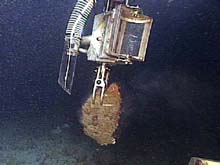
The Clelia submersible obtains a sample of limestone rock, which the researchers named "Hoagie," for analysis. Click image for larger view.
Getting to the Bottom of a Rocky Rubble Reef
September 9, 2001
Dr. Leslie R. Sautter
Dept. of Geology and Environmental Sciences
College of Charleston
Charleston, SC
The foundation of a reef ecosystem is its substrate. The term "substrate" refers to the geologic character of the local sea floor. Hard substrates are typically more stable than soft substrates and are more suitable habitats for organisms that prefer to be immobile. Most corals, sponges, and bryozoa -- common inhabitants of reefs -- need a hard substrate on which to anchor, to protect them from bottom currents and shifting sediments. Hard substrate is usually rock, although it can also be cement blocks, the hull of a sunken ship, or some other artificial reef surface. Biologists, geologists, and fishermen alikear often refer to hard substrates that harbor abundant communities of invertebrates and fish populations as hard-ground/live-bottom areas.
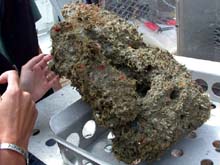
Close-up of "Hoagie," a limestone rock retrieved from Sandwich Reef. This rock is covered with living organisms, providing a microhabitat for a variety of species. Click image for larger view.
Sandwich Reef . . .
During a series of submersible dives on several locations within Savannah Scarp, we have seen a variety of rocky substrate "styles," each of which appears to attract its own specialized reef community. For example, on Sandwich Reef in the southwestern portion, the hard substrate available to reef communities is limestone rock rubble. These rocks are not found everywhere, but are concentrated along ridges that have relief of between 0.5 and 1 m (as much as 3 ft).
The rubble was found scattered among platform-like limestone outcrops, which produce overhanging ledges that are great hideaways for grouper and other demersal fish. These ledges were low, with relief of less than 1 m. In some areas, the flat platforms showed sinkhole-like depressions and cracks, allowing other fish to find homes.
Henry and Barans' 1984 studies of the Savannah Scarp showed that this limestone rock probably originated as loose grains of calcium carbonate sediment (oolitic sands, to be more precise) that were cemented together when the sea level was much lower, approximately 18,000 yrs ago. The rubble rocks observed at Sandwich Reef are pieces of the limestone pavement. In other words, the rubble rocks are, literally, "chips off the old block"!
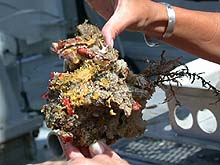
Found on a sea floor that is primarily covered by mobile sediment, this rock provides something to which organisms and invertebrates can attach themselves. Click image for larger view.
Between the rubble/outcrop ridges of Sandwich Reef lie flat plains of sediments, some of which undulate like small sand waves called mega-ripples. These ripples indicate that strong currents have occurred here, shifting the grains into small, migrating sand ridges. Compared to the rocky substrate areas, these sediment plains are sparsely populated. Different species of fish congregate here relative to the rocky areas. Tubeworms and sponges have also made this "countryside" area, away from the rocky "city," their home.
. . . and a Grinder at the Deli
At the Deli, slightly northeast of the Sandwich (the naming pattern now becomes more evident), similar rock rubble was found, though no ledges of pavement were observed. These rubble areas are separated by sediment plains which, presumably, are underlain by limestone pavement. Another piece of the rock -- "VJ's Grinder" -- was plucked from the sea floor here. This microhabitat displayed a different variety of species representing the same invertebrate groups found on the Sandwich, with the exception of white, putty-like encrusting tunicates.
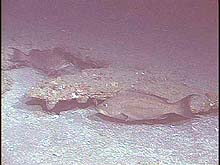
Two scamps and numerous cubbyu (underneath the rock) were seen at this rocky outcrop. Rocks are attractive to fish because of the amount of life that attaches to them, and also because they are good hiding places. Click image for larger view.
Moving away from the Deli and Sandwich reef areas, we explored a region of the Savannah Scarp known by fishermen as the Sow Pen, and another area we now refer to as the Sampler. These areas were quite different from the Deli/Sandwich vicinity. The Sow Pen and Sampler are mostly characterized by a broad, nearly featureless sediment blanket that rests on top of hard limestone pavement. This blanket, less than 20 cm thick, is composed of fragments of shell, coral, echinoderm spines, and bryozoa. Some areas appeared to be nearly devoid of macroinvertebrates (visible from the submersible), while other sandy plains were speckled with filter-feeding tubeworms and occasional starfish.
Very little rock rubble occurs along this portion of the Savannah Scarp, though one small piece was collected and was teeming with sponge, bryozoa, and other invertebrates. Reef communities in this area are primarily built on low-lying ledges (<0.5 m) and small crevasses in the cracks of the rock that thrive with life. Outcrops are small and far less numerous than the reefs of the Sandwich/Deli area. They support a very different, but diverse, community of demersal fish, particularly small black cubbyu. Triggerfish and gag grouper are common here as well.
The Savannah Scarp lies at the edge of the continental shelf, where the sea floor is eroded and fractured as it begins to descend to the deep sea. Our examination of these four dive sites has shown how important the substrate is, providing the foundation for reef habitat. It is likely that limestone exists extensively throughout the region and landward; however, it is most often buried by sediments and is unavailable as substrate to reef organisms. The Gulf Stream's influence on this area is significant, as it has helped to expose hard-substrate areas by shifting and eroding the sandy blanket. The limestone hard-ground ledges, outcrops, crevasses, and rocky rubble of the Savannah Scarp are deep-sea oases of marine life -- truly, they are Islands in the Stream.
Interview with Venetia Butler
Environmental Educator
Oatland Island Education Center
Savannah, GA

Venetia Butler, Environmental Educator at Oatland Island Education Center in Savannah, Georgia. Click image for larger view.
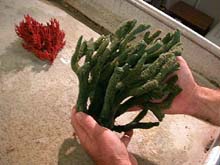
This sponge is yet to be identified. Collected at Savannah Reef on September 8. Click image for larger view.
Venetia Butler: I hold a M.S in Elementary Education and have 27 years of teaching experience. I've spent the last 15 years teaching in an environmental and outdoor education center. Many of the programs taught are based on the estuarine and barrier island systems. A number of years ago, I was one of 5 teachers who began the Tybee Island Marine Science Center. I have been a co-writer for several curriculums including the national award winning Coastal Studies for the Primary Grades. I am also a recipient of 2 marine science education awards. My background includes working on shrimp trawlers and a lifetime of playing in and exploring various marine habitats.
Ocean Explorer: What is your role on the Savannah Scarp mission?
Venetia Butler: My role here as an educator is to connect this wonderful experience with students and teachers on land. Prior to coming on this mission I met with approximately 200 students in 5 different schools in Savannah, GA. Those students are to check the daily logs on the web and send questions to me. I, in turn, will find the answers to those questions and email them back to the students. A group of high school students in St. Mary's, GA, is also participating in the project. When I return I will meet with the students in the different schools to answer more questions and share video footage, interview tapes and artifacts that were collected. While on board the vessel Seward Johnson II, I also assist the researchers and crew members in any way that I can.
Ocean Explorer: What do you hope to get out of this expedition?Venetia Butler: I cannot think of anything more exciting than actually taking part in the exploration of an area of the ocean bottom that no one has visually explored before. Since I teach science education to students and other teachers, I am finding this experience invaluable. I'm surrounded by oceanographers who are really making contributions to the world of science and are using some of the most modern tools of technology available. I have continually asked questions and have found everyone to be very generous with their time and knowledge. I am looking forward to going back to my regular teaching responsibilities armed with a much clearer understanding of research science and an abundant amount of information to share.
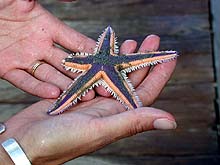
This starfish was collected in an area of Savannah Reef called Sow's Pen on September 8. Click image for larger view.
Ocean Explorer: How will you share your experience here at the Savannah Scarp mission in an educational format?
Venetia Butler: I will be meeting with the students and teachers who communicated with me to share my experiences while on this mission. I plan to develop a program to encourage teachers to take advantage of the many wonderful opportunities provided by Gray's Reef National Marine Sanctuary, NOAA, and the many programs that are becoming available. The teachers who teamed with me on this project will be joining me to make presentations at the Georgia Association of Marine Educators and Georgia Science Teachers Conferences. We will also collaborate on curriculum development based on the information and technology available through the NOAA programs.
Sign up for the Ocean Explorer E-mail Update List.











































